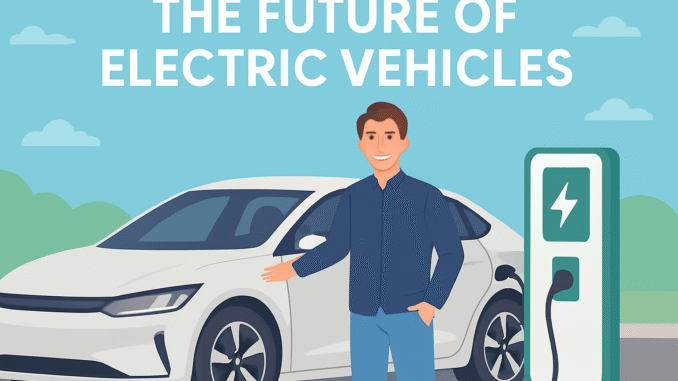
The Future of Electric Vehicles: Trends to Watch in 2025
The automotive industry is undergoing one of the most significant transformations in history, and at the heart of this change is the electric vehicle (EV). With governments pushing for cleaner energy, manufacturers investing billions in innovation, and consumers becoming more eco-conscious, 2025 is shaping up to be a defining year for electric mobility.
Electric vehicles are no longer just a futuristic concept; they are becoming mainstream. From advanced battery technology to autonomous features and sustainable production, there are many exciting trends reshaping the EV market. In this article, we’ll explore the key EV trends to watch in 2025 and how they are likely to influence drivers, automakers, and the global economy.
1. Greater Adoption of Solid-State Batteries
One of the biggest challenges EVs face today is battery technology. Traditional lithium-ion batteries are effective but have limitations in charging speed, lifespan, and safety. By 2025, solid-state batteries are expected to play a much bigger role.
- Why it matters: Solid-state batteries promise higher energy density, faster charging, and longer range.
- Benefits: Reduced risk of overheating, lower weight, and improved durability.
- Industry leaders: Toyota, Samsung, and QuantumScape are investing heavily in this technology.
Solid-state batteries could be the breakthrough that makes EVs more practical and appealing to the mass market.
2. Fast-Charging Networks Expanding Worldwide
Range anxiety—the fear of running out of power before reaching a charging station—has long been a barrier to EV adoption. However, charging infrastructure is improving rapidly, and by 2025, fast-charging networks will be more accessible.
- Ultra-fast charging: Many companies are working on chargers that can power an EV in under 15 minutes.
- Global expansion: Europe, the U.S., and Asia are heavily investing in nationwide charging networks.
- Smart charging: Integration with renewable energy and AI-based grid management will make charging more efficient.
This infrastructure growth will make EV ownership more convenient and encourage more people to switch from gas-powered cars.
3. Rising Popularity of Affordable EV Models
In the early days, EVs were considered luxury items with high price tags. But the landscape is shifting. Automakers are now introducing budget-friendly EVs that appeal to middle-class families.
- Lower prices: Thanks to economies of scale and government subsidies, EVs are becoming more affordable.
- Compact city cars: Smaller, efficient models are popular in urban areas with limited parking.
- Used EV market: As more EVs hit the road, a growing second-hand market will make them even more accessible.
By 2025, owning an EV will no longer be seen as a luxury but a practical and economical choice.
4. Autonomous and Connected Features in EVs
Electric vehicles are at the forefront of the self-driving revolution. In 2025, we can expect EVs to come equipped with advanced driver-assistance systems (ADAS) and connected technologies.
- Autonomous driving: While fully driverless cars may still be a few years away, features like self-parking, lane assist, and adaptive cruise control will be standard.
- Over-the-air updates: Just like smartphones, EVs will receive regular software upgrades for performance and safety.
- Vehicle-to-grid (V2G) communication: Cars will interact with power grids to supply stored energy when needed.
This integration of EVs with smart technology will create safer, more efficient transportation systems.
5. Focus on Sustainability Beyond Zero Emissions
While EVs already reduce carbon emissions compared to traditional cars, 2025 will see a stronger push toward sustainable production and recycling.
- Eco-friendly materials: Automakers are experimenting with recycled plastics, vegan leather, and renewable materials for interiors.
- Battery recycling: Companies are developing better ways to repurpose used batteries, reducing waste.
- Green factories: Manufacturers are committing to carbon-neutral facilities powered by renewable energy.
This holistic approach ensures that EVs are not just clean on the road but also environmentally responsible throughout their lifecycle.
6. Increased Competition Among Automakers
The EV market is no longer dominated by a handful of companies like Tesla. By 2025, nearly every major automaker will have a strong presence in the EV space.
- Legacy brands: Ford, Volkswagen, GM, and BMW are expanding their EV lineups.
- New players: Startups such as Rivian, Lucid Motors, and NIO are gaining momentum.
- Global competition: Chinese automakers like BYD and XPeng are aggressively entering international markets.
This competition will drive innovation, lower prices, and give consumers more options than ever before.
7. Growth of EVs in Emerging Markets
Until recently, EV adoption was concentrated in North America, Europe, and parts of Asia. By 2025, emerging markets will play a bigger role in the EV revolution.
- Government incentives: Countries like India, Brazil, and South Africa are offering subsidies and tax breaks.
- Affordable EVs: Lower-cost models are designed specifically for developing economies.
- Public transport electrification: Buses, taxis, and delivery fleets in emerging markets are increasingly switching to electric.
This expansion ensures EV growth is not just limited to wealthier nations.
8. Enhanced Range and Performance
One of the biggest concerns drivers have is whether EVs can match the performance of gasoline cars. By 2025, that debate may be over.
- Improved range: Many EVs will exceed 400–500 miles on a single charge.
- High performance: Sports EVs are achieving acceleration and top speeds that rival supercars.
- Durability: Better engineering will allow EVs to handle extreme climates and longer commutes.
Drivers will no longer have to compromise on power, speed, or distance when choosing electric.
9. Integration With Renewable Energy Sources
Electric vehicles and renewable energy go hand in hand. By 2025, the connection between EVs and clean power will be stronger.
- Home charging with solar: More households will pair EV charging stations with solar panels.
- Grid balancing: EVs will help stabilize energy grids by feeding power back during peak hours.
- Green energy incentives: Governments may reward EV owners for charging with renewable sources.
This synergy will accelerate the global transition to sustainable energy systems.
10. Policy Changes and Government Support
Governments worldwide are setting ambitious targets to reduce carbon emissions, and EV adoption is central to these plans. By 2025, stronger policies will reshape the automotive landscape.
- Bans on gas-powered cars: Several countries are phasing out sales of new combustion-engine vehicles.
- Tax incentives and rebates: Continued financial support will make EVs more attractive to buyers.
- Infrastructure funding: Public investment in charging stations will accelerate.
Policy support ensures that EVs remain a priority for both automakers and consumers.
Final Thoughts
The year 2025 will mark a turning point for electric vehicles. With advancements in battery technology, charging infrastructure, affordability, sustainability, and smart features, EVs will no longer be niche but mainstream.
For drivers, this means more choices, lower costs, and greater convenience. For manufacturers, it means intense competition and innovation. And for the planet, it means a critical step toward reducing carbon emissions and building a sustainable future.
As we look ahead, one thing is clear: the future of transportation is electric, and 2025 will be a milestone year that shapes the industry for decades to come.
